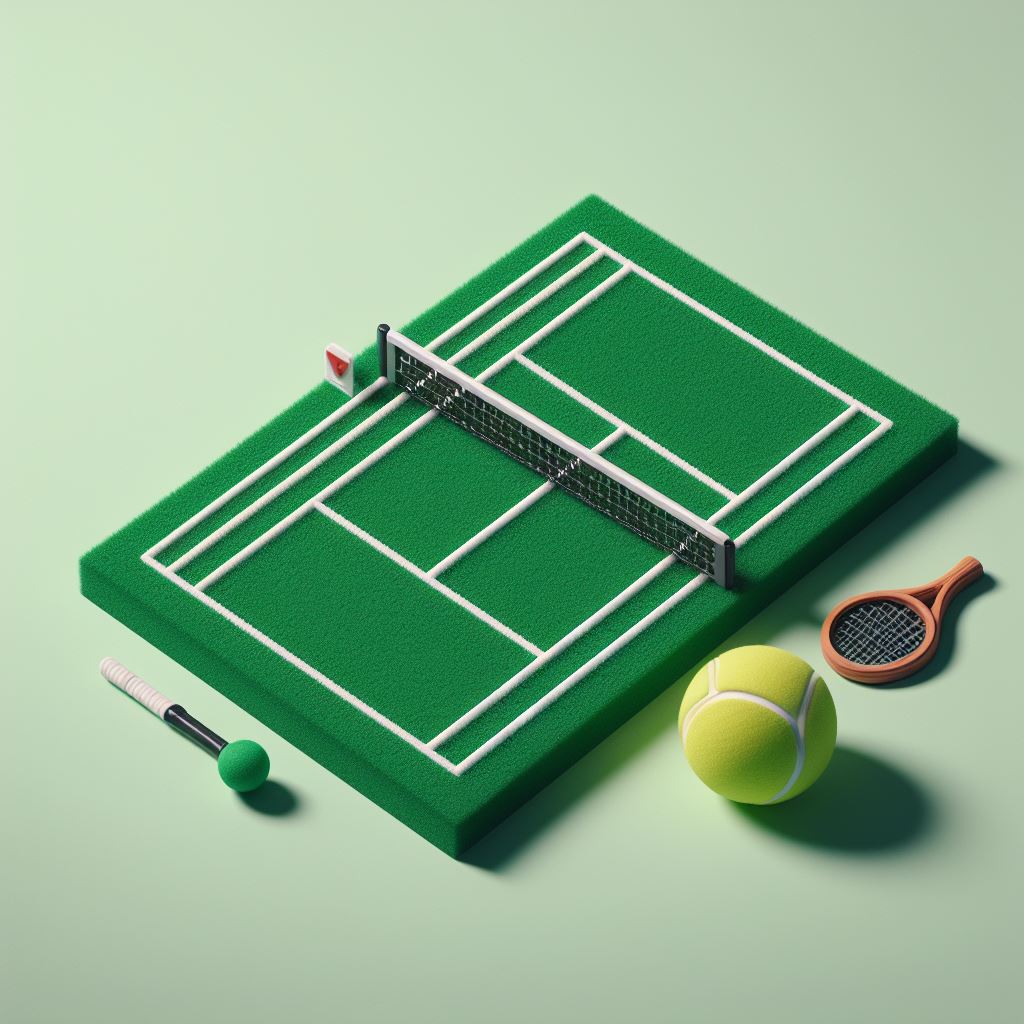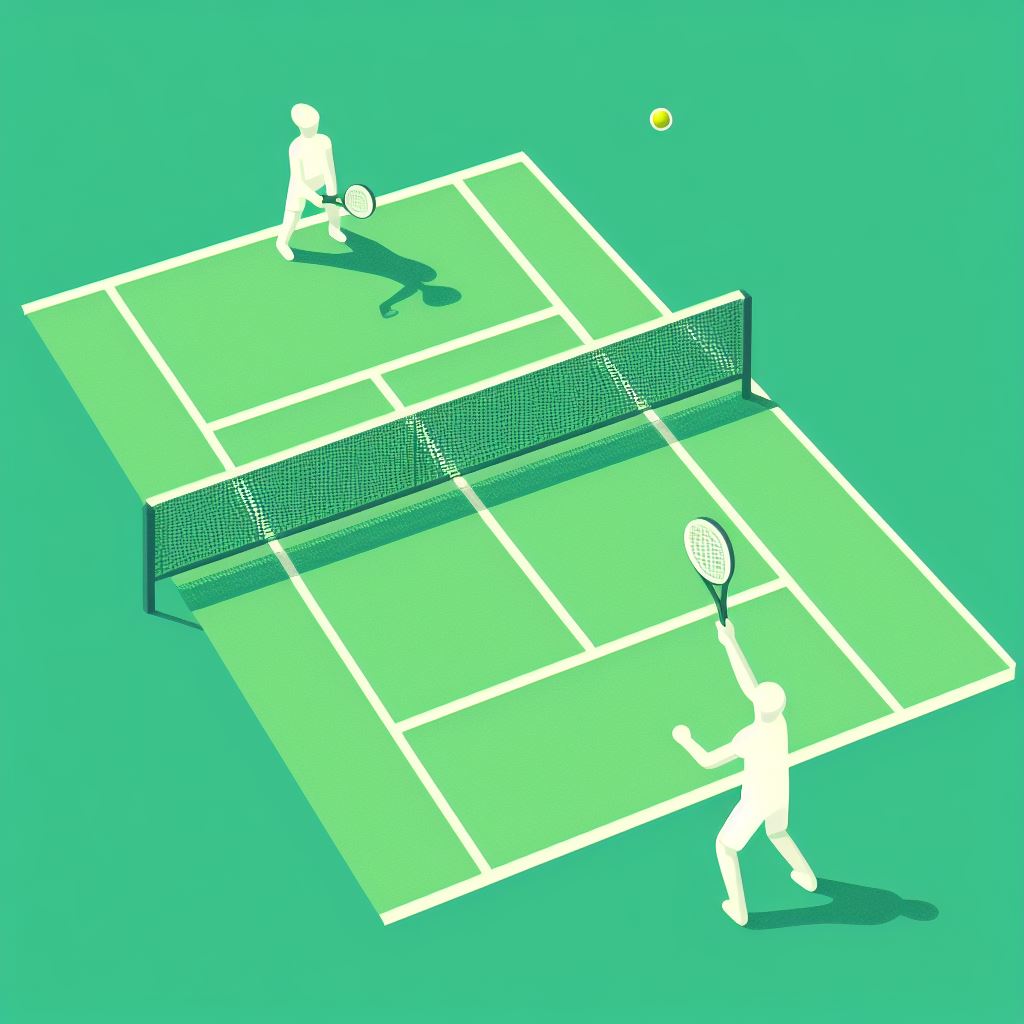Imagine stepping onto a vibrant green court, the sun shining brightly overhead, as you prepare to embark on a thrilling journey into the world of tennis.
In this introductory article, we will delve into the fundamentals of this captivating sport. From understanding the rules and scoring to mastering essential strokes, we will equip you with the knowledge and skills necessary to start your tennis journey on the right foot.
Get ready to unlock the secrets of tennis and embrace the thrill of the game.
Key Takeaways
- A standard tennis court is 78 feet long and 27 feet wide for singles matches, and 36 feet wide for doubles matches.
- There are three types of courts: grass courts, clay courts, and hard courts, each with their own pace and bounce characteristics.
- The scoring system in tennis includes ‘love,’ ’15,’ ’30,’ and ’40,’ and when the score reaches ’40-40,’ players must win two consecutive points.
- Essential tennis equipment includes a tennis racket, tennis balls, proper footwear, and comfortable clothing, and choosing the right racket depends on skill level and playing style.
The Basics of Tennis
The basics of tennis encompass the fundamental skills, rules, and strategies required to play the sport effectively.
Understanding the dimensions of a tennis court is crucial for any beginner. A standard tennis court is 78 feet long and 27 feet wide for singles matches, while doubles matches require a court that is 36 feet wide. The net is positioned at the center, dividing the court into two equal halves.
The playing surface can vary, with the three most common types being grass, clay, and hard court.
Grass courts have a faster pace and lower bounce, making them suitable for aggressive players who rely on their serve and volley.
Clay courts, on the other hand, are slower and provide a higher bounce, making it ideal for baseline players who prefer longer rallies.
Hard courts, which are made of asphalt or concrete, offer a medium pace and consistent bounce, making them a popular choice for professional tournaments.
Understanding the different surfaces and their characteristics is essential in developing a well-rounded game. It allows players to adapt their playing style and strategy accordingly, maximizing their chances of success on the court.
Understanding the Rules and Scoring
Moving on from the basics of tennis, it is important to delve into the rules and scoring of the game in order to fully grasp the intricacies of this popular sport.
Understanding the court dimensions:
- Tennis is played on a rectangular court, measuring 78 feet long and 36 feet wide for singles matches, and 78 feet long and 27 feet wide for doubles matches.
- The court is divided into two halves by a net, which is positioned 3 feet high at the center.
- The playing area is further divided into two service boxes, located diagonally across from each other.
Understanding the role of the umpire:
- The umpire is responsible for ensuring that the rules of the game are followed and for making decisions on disputed calls.
- They announce the score after each point, using a unique scoring system that includes ‘love’ for zero, ’15’ for the first point, ’30’ for the second point, and ’40’ for the third point.
- When the score reaches ’40-40,’ also known as ‘deuce,’ the players must win two consecutive points to secure the game.
Essential Tennis Equipment
To properly engage in the sport of tennis, it is crucial to have the necessary equipment. Tennis gear essentials include a tennis racket, tennis balls, proper footwear, and comfortable clothing. Among these, choosing the right tennis racket is perhaps the most important decision a player needs to make.
When selecting a tennis racket, several factors come into play. The first consideration is the grip size. It is vital to choose a grip size that feels comfortable and allows for a secure hold on the racket. The weight of the racket is another important factor to consider. Heavier rackets provide more power, while lighter rackets offer increased maneuverability. The head size of the racket also plays a role in the player’s performance. A larger head size provides a larger sweet spot, making it easier to hit the ball accurately.
Additionally, the player’s skill level and playing style should be taken into account when choosing a tennis racket. Beginners may benefit from a racket with a larger head size and a lighter weight, as it provides more forgiveness and maneuverability. Advanced players, on the other hand, may prefer a racket with a smaller head size and more weight for enhanced control and power.
Mastering Fundamental Strokes
To effectively develop mastery of fundamental strokes in tennis, it is imperative to consistently practice and refine one’s technique. Developing a proper grip on the racket is crucial for executing powerful and accurate strokes. The grip determines the angle of the racket face, which directly impacts the trajectory and spin of the ball. It is essential to learn the correct grip early on and practice it consistently to build muscle memory.
In addition to grip, footwork techniques play a vital role in mastering the fundamental strokes. Proper footwork allows players to position themselves optimally for each shot, enabling better balance, stability, and power. Learning how to move efficiently and quickly around the court, using small and controlled steps, is key to reaching the ball in time and maintaining proper body positioning.
Mastering fundamental strokes requires commitment, discipline, and a growth mindset. It is a journey that involves continuous practice and refinement. By developing a proper grip and mastering footwork techniques, players can enhance their stroke production and improve their overall game.
Strategies and Tactics for Success
Building upon the mastery of fundamental strokes, a player must develop effective strategies and tactics to achieve success in the game of tennis. One crucial aspect of developing a winning mindset is the ability to analyze opponents’ weaknesses.
To start, players should focus on their own strengths and use them to their advantage. By identifying their own skills, they can create a game plan that maximizes their strengths while minimizing their weaknesses. This strategic approach allows players to have a clear direction during matches.
Furthermore, analyzing opponents’ weaknesses is another key tactic for success. By observing their opponents’ playing style, players can identify patterns and areas of vulnerability. This information can then be utilized to exploit weaknesses and gain an upper hand in the match.
Additionally, players should be flexible and adaptable in their strategies. Tennis is a dynamic sport, and opponents may adjust their game plan throughout the match. Being able to quickly adapt and change tactics can give players a significant advantage.
Frequently Asked Questions
What Are Some Common Tennis Injuries and How Can They Be Prevented?
Common tennis injuries include sprains, strains, and tennis elbow. Prevention techniques such as proper warm-up, stretching, and using proper equipment can help reduce the risk. Rehabilitation methods may include rest, physical therapy, and gradual return to activity.
How Long Does It Take to Become Proficient in Tennis?
The average time it takes to become proficient in tennis varies depending on several factors, such as individual talent, dedication, and access to quality coaching. However, it is important to note that tennis has a steep learning curve and requires consistent practice and patience.
Are There Any Specific Warm-Up Exercises or Stretches That Should Be Done Before Playing Tennis?
Warm-up routines and stretching before playing tennis are essential for preventing injuries and enhancing performance. Incorporating specific warm-up exercises and stretches can help increase flexibility, improve blood flow, and prepare the body for the physical demands of the game.
What Are the Different Types of Tennis Court Surfaces and How Do They Affect Gameplay?
There are several types of tennis court surfaces, including grass, clay, and hard court. Each surface has unique characteristics that can affect gameplay, such as the speed of the ball and the amount of traction on the court.
Can Tennis Be Played Indoors and What Are the Differences Between Indoor and Outdoor Tennis?
Indoor and outdoor tennis differ in playing conditions and court surfaces. Indoor tennis provides a controlled environment, shelter from weather, and consistent court conditions. However, outdoor tennis offers natural elements, varying court surfaces, and a more traditional playing experience.
Conclusion
In conclusion, tennis is a sport that requires a solid understanding of the rules, knowledge of essential equipment, and mastery of fundamental strokes. By employing effective strategies and tactics, players can achieve success on the court.
For example, consider a hypothetical case study of a novice tennis player who diligently practices their strokes and studies the game’s strategies. Through perseverance and dedication, they eventually become a competitive player and experience the joy of winning matches.
Tennis offers a rewarding and challenging experience for those who are willing to put in the effort.








No Comment! Be the first one.